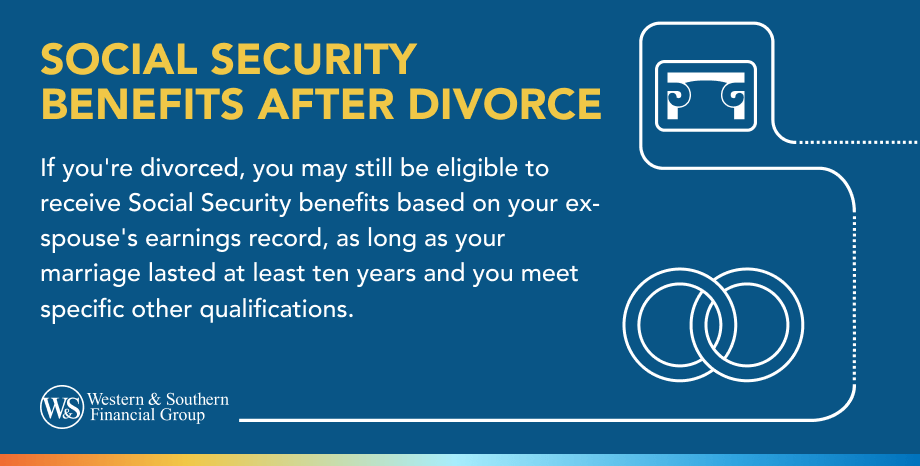

Table of Contents
Key Takeaways
- To qualify for spousal Social Security benefits, individuals must meet specific criteria, including being married for at least 10 years and staying single post-divorce.
- Individuals must be at least 62 years old to receive spousal Social Security benefits.
- The spousal benefit is calculated by subtracting 50% of the individual's own PIA from 50% of the former spouse's PIA.
- Those born before January 2, 1954, could use a "restricted application" to claim spousal benefits while delaying their own retirement credits.
Even if your marriage ended in divorce, you may still be entitled to spousal Social Security benefits based upon your former spouse's work record. Meeting the eligibility requirements for spousal Social Security benefits after divorce could make a big difference in your retirement income.
Divorce is challenging, but Social Security benefits don't need to be. Here's what you need to know about divorce and Social Security.
Post-Divorce Eligibility
While the Social Security Administration (SSA) extends spousal benefits to divorced couples, not every formerly married beneficiary is eligible for them. There are several factors that determine eligibility for spousal Social Security benefits based on your former spouse's work record:
- Marriage Length: Your marriage must have lasted at least 10 years to be eligible.
- Your marital status: You must remain single post-divorce to be eligible. However, you may still be eligible for spousal Social Security benefits if you remarried and that later marriage ended in death, divorce or annulment.
- Your former spouse's marital status: If your former spouse has remarried, but you've remained single, you may still collect spousal Social Security benefits without affecting the benefits your former spouse and their new spouse are entitled to receive.
- Age: You must be at least 62 years of age to collect spousal Social Security benefits based on your former spouse's work record.
- Death: If your former spouse has passed away, but you meet the first four requirements, you may be eligible for benefits as a widow or widower, according to the SSA.1
- Age of eligibility: You're eligible for spousal benefits if your former spouse qualifies for their own Social Security retirement benefits — even if your former spouse has not yet applied for these benefits. However, you must be divorced for at least two years before you apply.
- Early retirement: If you file for spousal Social Security benefits before reaching your full retirement age, you'll receive the spousal benefit plus your own retirement benefit, minus a reduction amount. Both benefits will be reduced based on the number of months you have to go until you reach your full retirement age.
There is one significant difference between spousal Social Security benefits for married and divorced couples: For married couples, it's necessary for the higher-earning spouse to apply for their own retirement benefits before the lower-earning spouse can apply to receive spousal benefits. This is not a requirement for divorced couples.
Social Security Benefits After Divorce
How much can you expect to receive? This is a question many divorcees ask about spousal Social Security benefits. Of course, the benefit amount depends upon several factors like your date of birth, as well as your and your former spouse's primary insurance amount (PIA). A PIA is the amount of money you're entitled to in retirement benefits once you reach your full retirement age, according to the SSA.2
If you were born on or after January 2, 1954, the SSA determines the benefit amount by starting with your and your former spouse's PIA. Your spousal Social Security benefits are based entirely on the following calculation: take 50 percent of your former spouse's PIA and subtract your PIA. This is amount will equal your spousal benefit. This means that if you out-earned your former spouse, you're unlikely to receive a spousal benefit.
If you were born before January 2, 1954, you may be entitled to a higher spousal Social Security benefit. Until the passing of the Bipartisan Budget Act of 2015, eligible beneficiaries could file solely for spousal benefits using a strategy known as "restricted application," which allowed a beneficiary to collect an auxiliary benefit while allowing his or her own retirement benefit to collect delayed retirement credits.3 After the act passed, restricted application was limited to beneficiaries born before January 2, 1954.
For such beneficiaries, spousal benefits can be calculated as 50 percent of their spouse's (or former spouse's) PIA — provided the beneficiary waits until full retirement age to file a restricted application for spousal benefits. Doing so allows the beneficiary to collect delayed retirement credits on their own retirement benefits, which can result in higher benefits overall.
A Question of When
Social Security benefits after divorce can increase your monthly benefits check, but the amount you receive will also depend on when you take your spousal Social Security benefit. Although you are eligible for Social Security benefits as early as age 62, early retirement will result in a permanent reduction of your monthly benefit, according to the SSA.4 The reduction amount for your spousal benefit and your retirement benefit also depends on how far away you are from your full retirement age.
If you're still working before reaching your full retirement age when you decide to start taking benefits, you may be subject to the earnings test, according to the SSA.5 What this means is that you'll see $1 deducted from your benefits for every $2 you earn over $23,400 for 2025. If you're within a year of your full retirement age, however, the income limit is much higher ($62,160 as of 2025) and the benefit reduction lower: $1 reduction for every $3 earned over the limit.
Divorce can be challenging but knowing your Social Security benefits as a former spouse could help you stay on track toward your financial goals.
Sources
- If You Are the Survivor. https://www.ssa.gov/benefits/survivors/ifyou.html.
- Starting Your Retirement Benefits Early. https://www.ssa.gov/benefits/retirement/planner/agereduction.html.
- H.R.1314 - Bipartisan Budget Act of 2015. https://www.congress.gov/bill/114th-congress/house-bill/1314/text.
- Benefit Reduction for Early Retirement. https://www.ssa.gov/oact/quickcalc/earlyretire.html.
- Exempt Amounts Under The Earnings Test. https://www.ssa.gov/oact/cola/rtea.html.















